
YOU WILL NEED
Terracotta pot
Drainage crocks
Potting mix
Grit, coarse sand, or gravel
Pebbles
plants:
3 Bidens ‘Moonlight’ (tickseed)
1 Citrus japonica (kumquat tree)
3 Erigeron karvinskianus (Mexican fleabane)
6–8 Hedera (ivy)
For a touch of the Mediterranean, how about growing a citrus tree? Kumquat trees grow happily in pots and will reward you with lots of fruit if a high-nitrogen fertilizer is used regularly throughout spring and summer. They can be kept outside in a sunny, sheltered spot during the warmer months, but will appreciate being moved indoors over winter. I underplanted the kumquat shown here with daisy-like bidens and erigeron, and trailing ivy.

YOU WILL NEED
Terracotta pot
Drainage crocks
Potting mix
Grit, coarse sand, or gravel
Pebbles
plants:
3 Bidens ‘Moonlight’ (tickseed)
1 Citrus japonica (kumquat tree)
3 Erigeron karvinskianus (Mexican fleabane)
6–8 Hedera (ivy)

1 Soak the rootballs of all the plants in water for about 10 to 20 minutes, or until they are wet through. The kumquat will need at least 20 minutes. Cover the holes in the bottom of the pot with a few drainage crocks to prevent them becoming blocked with potting mix.

2 Fill the pot approximately half full with potting mix, incorporating some grit, sand, or gravel (whatever you have at hand) as you do so to improve drainage.

3 Take the kumquat from its plastic pot, gently breaking up the rootball first, and plant it in the middle of the terracotta pot.

4 Remove the erigeron and bidens from their plastic pots next and plant them around the edge of the pot, allowing the stems to trail over the edge slightly.
5 Plant the ivies around the edge of the pot in the same way, tucking them between the other plants. Add more potting mix to fill any gaps between the plants, as required. Firm in the plants and level the surface of the potting mix.

6 Cover the surface of the potting mix with some pretty pebbles, which not only adds a decorative touch, but also helps to keep the potting mix moist.

AFTERCARE
Water the pot generously over the summer and feed regularly with a high-nitrogen fertilizer. Over the winter, let the surface of the potting mix dry out between waterings.